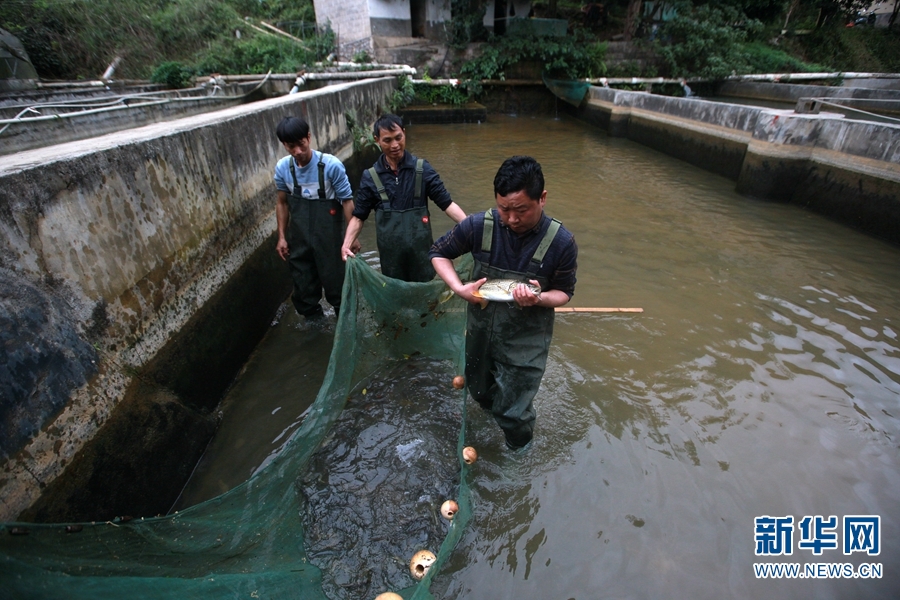
"Yunnan Pearl River Water System Rare Fish Conservation Base" is located in Lubuge Township, Luoping County, Qujing City, Yunnan Province, where a group of R&D personnel have been stationed for a long time, who are doing the domestication and breeding of rare wild indigenous fish day after day, helping the biodiversity conservation of the Pearl River system. The picture shows the R&D personnel inspecting the growth status of the fish in the fish pond. (Xinhua News Nian Xinhong / Wen Zhao Pufan / Photo)
The picture shows The Lubuge Township and the Duoyi River in aerial view. The Doi River, which flows through The Doi River in Lubuge Township, belongs to the Pearl River system, and once had flocks of fish and shrimp in the river, and there were wild fish species such as dark-lipped catfish, narrow-hole golden-lined catfish, flower perch carp, three-toothed Chinese tassel, and six-whiskered catfish. Due to overfishing, these fish are gradually becoming extinct. (XinhuaNet Zhao Pufan /Photo)
The picture shows Liu Xing, the director of the Lubuge Township Aquatic Products Station, walking between the fish ponds. In order to maintain the ecological balance of the Pearl River system and protect the endangered fish and their habitat ecosystems in the Duoyi River, in 2012, the Lubuge Township Aquatic Products Station took the lead in launching the domestication and artificial breeding of rare wild indigenous fish in the Pearl River system. (XinhuaNet Zhao Pufan /Photo)
In the fish pond of the "Pearl River Water System Rare Fish Conservation Base in Yunnan Province", Liu Xing is inspecting the growth status of fish. (XinhuaNet Zhao Pufan /Photo)
Dark-lipped carp, mainly distributed in the Pearl River system in China, because of its extremely high water quality requirements, coupled with overfishing, is now very rare in the wild, is One of the earliest indigenous fish domesticated by Liu Xing and his team. (XinhuaNet Zhao Pufan /Photo)
The picture shows Liu Xing and his colleagues inspecting the hatching of fish eggs. In the early days of breeding wild indigenous fish, there was no experience to learn from, and everything had to start from scratch. Taking the dark-lipped carp as an example, when it was just recovered from the wild in 2012, Liu Xing didn't even know what feed to feed, let alone its growth habits, and after a few days of raising, the fish turned over their white bellies one after another. Later, Liu Xing and his team gradually explored their food requirements by building caves in fish ponds, diverting water, simulating the wild environment, and rotating feeding various types of feed. (XinhuaNet Zhao Pufan /Photo)
The picture shows the dark-lipped carp in the fish pond of the "Pearl River Water System Rare Fish Conservation Base in Yunnan Province". After repeated experiments, in 2014, Liu Xing and his team increased the domestication survival rate of the dark-lipped carp to 20%, basically mastering its feeding habits and habits; in 2015, the first spawn was achieved; in 2016, artificial breeding was successfully realized. (XinhuaNet Zhao Pufan /Photo)
The picture shows the "Rare Fish Conservation Base of the Pearl River System in Yunnan Province" from the aerial perspective. Following the dark-lipped carp, Liu Xing and his team successfully domesticated and bred a number of indigenous fish species. Up to now, 15 species have been successfully domesticated, including three national second-level protected wild animals, namely flower perch, pointed goldenrod and narrow-bore goldenrod; 5 varieties have been successfully bred, of which "a fry breeding method of dark-lipped carp" and "a fry breeding method of southern white turtle" have been patented. (XinhuaNet Zhao Pufan /Photo)
Looking at the "sample fish" caught from the fish pond growing well, Liu Xingxi smiled. Looking back on the research and development road of the past 10 years, Liu Xing sighed, "The breeding cycle of wild indigenous fish is long, the speed is slow, and the difficulties are great. (Xinhua News Zhao Pufan /Photo)
In recent years, with the successful breeding of more and more indigenous fish species, many scientific research institutes and aquatic enterprises have come to learn knowledge and technology from Liu Xing and his team. The picture shows Liu Xing explaining relevant knowledge to two students of Yunnan Agricultural University. (XinhuaNet Zhao Pufan /Photo)
The picture shows Liu Xing inspecting the growth status of fish. After nearly 10 years of efforts, the "Pearl River System Rare Fish Conservation Base in Yunnan Province" has provided more than 600,000 fry for the breeding and stocking of the upper reaches of the Pearl River, with significant ecological effects. In addition, the base has also provided more than 1 million fish fry for each farm, pushing the research and development results to the market and the table, and helping rural revitalization. (XinhuaNet Zhao Pufan /Photo)
The picture shows Liu Xing inspecting in the field. In the future, Liu Xing and his team will further expand the scope of research and development, tackle more domestication and breeding technologies for rare wild indigenous fish, and make more and greater contributions to the protection of indigenous fish in the Pearl River system and the protection of the biodiversity of the Pearl River system. (XinhuaNet Zhao Pufan /Photo)